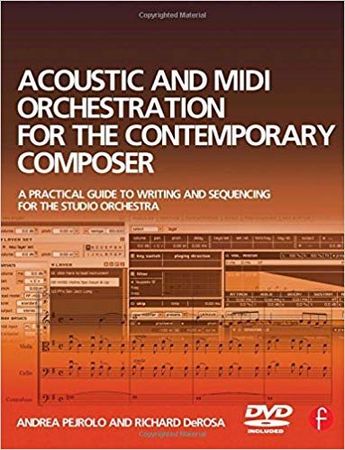2007 | 306 pages | PDF | 13 MB
This unique book is a complete guidance on both traditional orchestration and modern production techniques. With effective explanations and clear illustrations, you will learn how to integrate the traditional approach to orchestration with the modern sequencing techniques and tools available. You will discover how to bridge the two approaches in order to enhance your final production.
This unique book is a complete guidance on both traditional orchestration and modern production techniques. With effective explanations and clear illustrations, you will learn how to integrate the traditional approach to orchestration with the modern sequencing techniques and tools available. You will discover how to bridge the two approaches in order to enhance your final production.[/center]
This unique book is a complete guidance on both traditional orchestration and modern production techniques. With effective explanations and clear illustrations, you will learn how to integrate the traditional approach to orchestration with the modern sequencing techniques and tools available. You will discover how to bridge the two approaches in order to enhance your final production.
The book provides a comprehensive and solid learning experience that will develop your skills and prove extremely competitive in the music production business.
Contents:
Foreword
Acknowledgments
1. Basic Concepts for the MIDI Composer, Arranger, and Orchestrator
1.1 Introduction to MIDI and audio sequencing
1.2 Review of the MIDI standard
1.3 MIDI messages and their practical applications
1.4 Principles of orchestration
1.5 Final considerations
1.6 Summary
1.7 Exercises
2. Writing and Sequencing for the Rhythm Section
2.1 Introduction: general characteristics
2.2 The components of the rhythm section
2.3 The role of the essential instruments
2.4 Color and style
2.5 Writing parts for the rhythm section
2.6 Sample scores for the rhythm section
2.7 Sequencing the rhythm section: an introduction
2.3 The synthesizer
2.9 Sequencing for the guitar: overview
2.10 Sequencing for the bass: overview
2.11 Sequencing for drums and percussion: overview
2.12 Mixing the virtual drums and percussion
2.13 Final considerations on sequencing for the rhythm section: tempo changes
2.14 Summary
2.15 Exercises
3. Writing and Sequencing for the String Orchestra
3.1 Introduction: general characteristics
3.2 Creating sound
3.3 Performance techniques for greater expression
3.4 The specific instruments
3.5 Orchestration examples
3.6 The harp
3.7 Sequencing for the string orchestra
3.3 MIDI sequencing techniques for strings
3.9 Hardware MIDI controllers for string sequencing
3.10 Sequencing for the harp
3.11 Mixing the string section
3.12 The final touches
3.13 Summary and final considerations on writing and sequencing for the string orchestra
3.14 Exercises
4. Writing and Sequencing for the Woodwind Section
4.1 General characteristics
4.2 The woodwind section
4.3 Creating sound
4.4 The specific instruments
4.5 The saxophones
4.6 Concerns regarding orchestration
4.7 Sequencing for the woodwind section: an introduction
4.3 Synthesis techniques and library options
4.9 Sequencing techniques for the woodwind section: input controllers
4.10 Use of MIDI control changes and editing techniques
4.11 Performance controllers
4.12 Performance extended controllers
4.13 Special sequencing techniques for woodwind: the saxophone section
4.14 Final touches
4.15 Mixing the woodwind section
4.16 Summary
4.17 Exercises
5. Writing and Sequencing for the Brass Section
5.1 General characteristics
5.2 The brass section in the orchestra
5.3 The brass section in the jazz band
5.4 Creating sound
5.5 The specific instruments
5.6 Mutes
5.7 Orchestrating the brass
5.3 Sequencing for the brass section: an introduction
5.9 MIDI controllers for sequencing the brass section
5.10 Sequencing techniques for the brass instruments
5.11 Performance controllers for the brass
5.12 Extended performance controllers: attack and brightness
5.13 Advanced sequencing techniques for the brass: detuning
5.14 Addition of real instruments
5.15 The final touch: performance noises
5.16 Mixing the brass section
5.17 Summary
5.13 Exercises
Appendix A: Music Scores
DVD Audio Examples List
[toggle title=”Home page”]https://tinyurl.com/tvnftpm[/toggle]

http://alfalink.to/56add98fbde1aae19224
Please REPORT in Comment Broken Links


